
2011 4th Issue
Feature Article
Oyster Orgy
As winter approaches, oysters become in season, and oyster lovers are gearing up for their hearty feasts. Many people may like to prepare an "oyster feast" at home. However, when handled improperly, oysters can cause illness, ruining more than just a gourmet dinner.
Oysters, just like other shellfish, are filter-feeders, consuming plankton while filtering the water for food. Thus, they are easily contaminated by bacteria (e.g. Vibrio parahaemolyticus) and viruses (e.g. hepatitis A virus and norovirus). Consumption of undercooked oysters contaminated with pathogens may pose a high risk of foodborne illness.
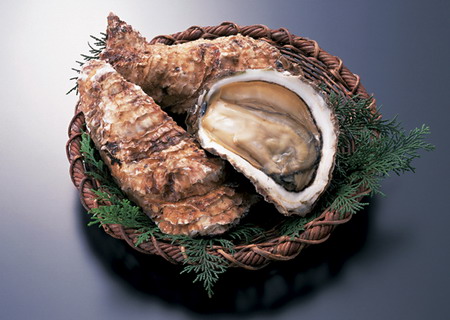
Oysters are susceptible to contamination by pathogens like bacteria or virus, and must be thoroughly cooked before consumption.
In preparation of oysters (e.g. deep-fried oyster, braised oyster with ginger and spring onion, and oyster hotpot), we must remain vigilant in ensuring food safety. Apart from observing personal, utensil and environmental hygiene, we should take the following precautions:
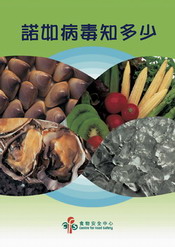
- Purchase:
- Buy oysters only from reliable shops.
- Buy oysters that are fresh and free from abnormal odour. For prepackaged oysters, check carefully the expiry date printed on the label.
- Pay attention to whether the shop have kept the oysters at a proper temperature, i.e. fresh oysters should be stored at 4°C or below and frozen oysters at -18°C or below.
- Storage:
- Oysters must be stored at a proper temperature within two hours upon purchase.
- Oysters must be put in containers with lids before refrigeration and stored below cooked food or ready-to-eat food. Avoid contact with other cooked food or ready-to-eat food to prevent cross-contamination.
- Fresh oysters stored at a proper temperature should be consumed within one or two days, whereas prepackaged oysters should be consumed before the expiry date to ensure quality and food safety of the oysters.
- Preparation:
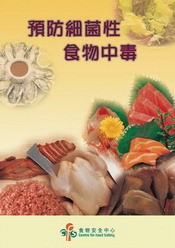
An array of pamphlets and guidelines are provided by the CFS for reference of the public and the trade.- Thaw the oysters completely under running water.
- Wash hands thoroughly with soap for 20 seconds before and after handling the oysters to prevent cross-contamination with other cooked food or ready-to-eat food.
- Use separate utensils to handle raw oysters and cooked food or ready-to-eat food to avoid cross-contamination.
- Before cooking, wash the oysters and their shells thoroughly.
- Remove the intestines of oysters completely before cooking.
- Cooking:
- Scald the oysters in boiling water for not less than three minutes before cooking to eliminate the bacteria and viruses in the oysters.
- Cook the oysters thoroughly, ensuring heating to a core temperature of 90°C for 90 seconds.
- Do not cook a large amount of oysters in one go as this will cause uneven heating and result in some of the oysters not fully cooked to the required core temperature.
- Consumption:
- When having hotpot, use separate chopsticks and utensils for handling raw and cooked foods to prevent cross-contamination.
- To ensure thorough cooking, wait until the hotpot soup is boiling hot before adding the food.
Readers' Corner
Plasticiser Incident

Various juice drinks were found to contain plasticisers by the Taiwan authority.
In May 2011, the Food and Drug Administration (FDA) in Taiwan announced that a plasticiser di(2-ethylhexyl)phthalate (DEHP) had been detected in 16 samples of drinks. Subsequently, more foods were found to contain DEHP as well as other plasticisers, including di-isononyl phthalate (DINP) and di-butyl phthalate (DBP). Investigations conducted by the Taiwan authority revealed that clouding agents (i.e. emulsifiers) containing plasticisers were found to be added to food products and the clouding agents concerned were formulated by two manufacturers using plasticisers in an attempt to reduce cost and increase stability.
Following the Taiwanese announcement, the Centre for Food Safety (CFS) has maintained contact with the Taiwan authority and collected samples of food likely to be contaminated by plasticisers for testing. As of 30 September 2011, more than 1 020 food samples were tested. Among them, 49 samples were found unsatisfactory and confirmed to be tainted by plasticisers. The CFS immediately notified the trade and made announcements advising the public not to consume the products in question.
From 24 August 2011 when the last unsatisfactory sample was found to the end of September 2011, all plasticiser test results for a cumulative total of 123 food samples were satisfactory. In view of this, the CFS decided to subsume the testing of plasticisers in food, conducted previously under a targeted approach, within its routine food surveillance programme from 3 October 2011 onwards. The test results will be announced in the Food Safety Report issued monthly and available on the following website:
http://www.cfs.gov.hk/english/consumer_zone/
foodsafety_surveillance.html
Food Safety Charter 2011/12
Launched in 2008, the Food Safety Charter (the Charter) is an endeavour jointly promoted by the Centre for Food Safety (CFS) and the food trade. Each signatory of the Charter is committed to upholding food safety as the focus of attention in the provision of quality services to customers. This year, a total of 21 food trade associations and over 2 200 food premises, food retailers and other members of the food trade have signed up to the Charter, among which more than 1 300 signatories have kept up their commitment for three consecutive years since 2009 and they will be granted a Star Award/Award to showcase their determination in ensuring food safety.
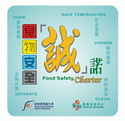 |
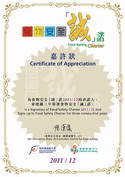 |
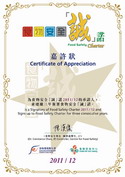 |
During the year, the CFS held a series of roving exhibitions on the Charter in various districts with a new set of exhibition panels. Apart from introducing the Charter, these panels also provided information on the Hazard Analysis and Critical Control Point (HACCP) System as well as the risk management measures taken by the signatories in their day-to-day operations, with a view to enhancing public knowledge on the signatories' efforts in ensuring food safety. Moreover, information of all signatories by districts was displayed on monitors for public access.
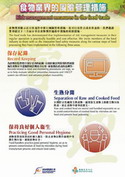 |
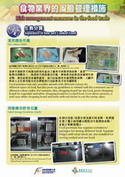 |
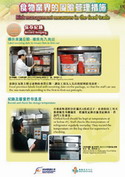 |
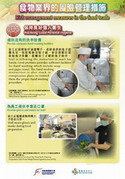 |
A new set of exhibition panels for the Food Safety Charter showing measures taken by the signatories in ensuring food safety
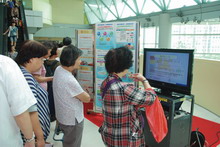
Information of signatories is displayed on monitors during roving exhibitions
A signatory list is posted on the CFS's website (www.cfs.gov.hk) for public access. In addition, the mobile application FSCharter is now available for download via smart phones. This mobile application not only facilitates the public to obtain information and brief guides of the signatories at any time and at any place, but also enables users to make reservations by phone, thus drawing the public and the signatories much closer together.

FSCharter facilitates public searching of signatories' information
News on New Dishes
Delicate Cooking of the Delicious "Osmanthus Honey Rice Cake"
The Bulletin has interviewed "Xiao Nan Guo", a signatory of the Food Safety Charter. "Xiao Nan Guo" specialises in Shanghai cuisine. The masterful Shanghai chefs will each day meticulously prepare delicious and unique Shanghai dishes that are well received by diners. "Osmanthus Honey Rice Cake" is one of the famous desserts produced by "Xiao Nan Guo". Mr. TUNG Man-hong, the Executive Chef – South China & Overseas Market of "Xiao Nan Guo", will teach us how to prepare this dessert.
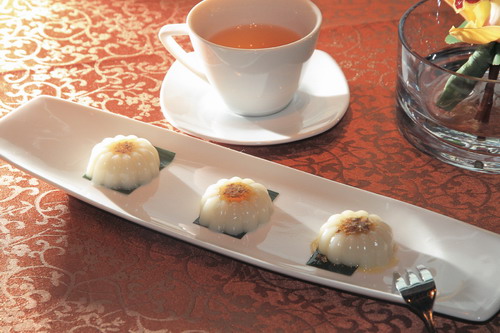
Osmanthus honey rice cakes ready to serve
Ingredients:
| Ingredients for the Rice Cake |
Tips | |
|---|---|---|
| Glutinous rice flour | Use a sieve to sift the flour so as to remove foreign objects or coarse particles, leaving the flour smooth and fine. |  |
| Granulated white sugar | Do not use sugar that has got damp or is mixed with impurities. | |
| Boiled Water | Use filtered water or boiled water only. | |
| Peanut oil | It can be replaced by olive oil. | |
| Wine | Use Wuliangye liquor which has a special fragrance. | |
| Ingredients for the osmanthus syrup | Tips |
|---|---|
| Dried osmanthus flowers | Purchase quality osmanthus flowers that are free of impurities, withered petals and dead insects. |
| Syrup |
Cooking Method:
| Preparation of the osmanthus syrup | Tips |
|---|---|
| Rinse osmanthus flowers and pat dry with paper towels. Set aside. | Use clean absorbent paper towels to dry them thoroughly, otherwise the flowers will stick together. |
| Cook the syrup with low heat. When it gets hot, add osmanthus flowers and stir well. Simmer for a few minutes until the syrup is permeated with the scent of osmanthus. | Do not rush. The syrup must be cooked with low heat, otherwise it will burn. |
| Preparation of the Rice Cake | Tips | |
|---|---|---|
| Mix glutinous rice flour and white granulated sugar in a bowl. Add peanut oil and wine and blend them together with hands until the mixture is dampened. | Pay attention to whether there are foreign objects such as dead insects in the mixture during blending. |
 |
| Add a small amount of boiled water (approximately two or three tablespoons) and continue to stir until the mixture is fully blended. Repeat the procedure above until the mixture forms a smooth batter. | Check that there is no contaminant in the boiled water. Do not add a lot of water in one go. Add water slowly and keep stirring until the mixture is well blended. Make sure there are no lumps in the batter or it may affect the texture. | |
| Pour the batter into the moulds and cover them with microwave-safe plastic wrap. | Do not fill up the mould to the rim. Cover with microwave-safe plastic wrap to avoid any condensation dripping onto the batter. | |
| Place the moulds in the steamer or wok when water is boiled up. With the lid on, steam for 20 minutes. | Do not put the moulds in the steamer or wok before water is boiled up. |
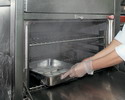 |
| Remove steamed cakes from the moulds and place them on a plate. Pour osmanthus syrup over the cakes and serve. | The cake tastes much better when it is hot. |
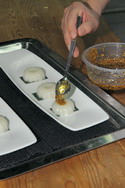 |
Tips from Chef TUNG:
The "Xiao Nan Guo" Group purchases ingredients from reputable licensed food suppliers to reduce any food safety risks. In doing so, in case there are problems with the food, the source is traceable. When necessary, the staff will ask the suppliers to provide health certificates for the ingredients. After receiving the stocks, they will carefully check the quality and package of the food and demand the return of any problem food to the suppliers immediately. Quality ingredients can make both tasty and safe food.
Chef TUNG specifically mentioned that the starters, desserts and main courses of their Group were all made to order. This not only ensures the delicious taste of the dish, but also prevents cooked food from cross-contamination during storage.
The Group also attaches great importance to hygiene training for their staff and stresses good personal hygiene. For example, the staff are required to take off their accessories when preparing food in order to prevent the accessories from falling into the food. This can also avoid transmitting bacteria to the food through the accessories which may harbour dirt. Kitchen staff must wear gloves which have been sprayed with edible disinfectant during the preparation of food. In addition, the worktops must be washed before and after work, and must be cleaned with edible disinfectant before the handling of food. To enable the staff to meet the hygiene requirements, all kitchens under the Group are provided with adequate facilities and items, such as disinfecting fluid and plastic gloves.
Being a signatory of the Food Safety Charter, the "Xiao Nan Guo" Group aims at providing high quality food. The Group also joins hands with the Government to promote food safety to the public.
Food Safety Plan Corner
Preparation of the Delicious "Osmanthus Honey Rice Cake"
Ingredients:
Glutinous rice flour, granulated white sugar, peanut oil, Wuliangye liquor, dried osmanthus flowers and syrup
- Place glutinous rice flour and granulated white sugar in a bowl and mix well. Add peanut oil and Wuliangye liquor to the mixture and stir until it is completely moistened.
- Add two to three tablespoons of water. Keep stirring until water fully blends with the mixture and to form a batter.
- Pour the batter into a steam mould. Cover with plastic wrap. Steam in a pre-heated steamer for 20 minutes. Then remove the well-cooked rice cake from the mould.
- Rinse the dried osmanthus flowers and pat them dry. Cook syrup over low heat until it is lukewarm. Add the osmanthus flowers and cook briefly. Pour the syrup over the rice cake to serve.
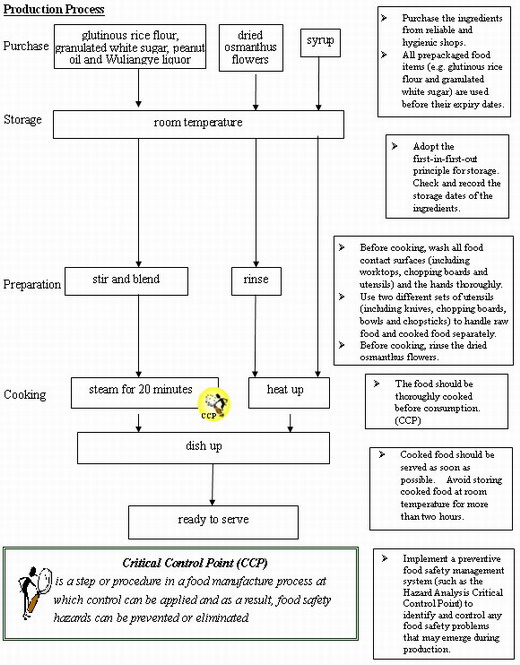
Briefing of Activities
(1) Food Hygiene Seminar (Public Series)
The Centre for Food Safety (CFS) organised three sessions of Food Hygiene Seminar (Public Series) during October and November 2011. Target participants were members of the public and employees of the food business. The theme of the seminar was to promote proper food handling. Speakers explained to the participants the Hazard Analysis and Critical Control Point (HACCP) System. The CSF hoped, through the tripartite collaboration among the Government, stakeholders and consumers, to actively promote to the industry the adoption of the HACCP System and the development of "Food Safety Plan", thereby enhancing food safety in Hong Kong.
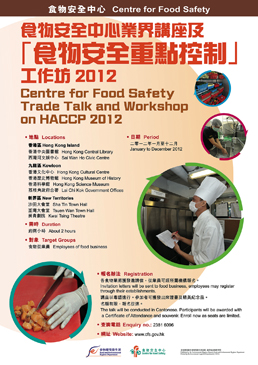
(2) Roving Exhibitions on Food Safety
The CFS holds exhibitions in shopping centres of public and private housing estates across the territory every year. Panels covering different topics such as food safety or nutrition, and educational videos are on display to educate the public on how to make food choices that are safe and can suit their needs. Games are also available at these exhibitions to give out souvenirs to participants. For the latest arrangements of the exhibitions, please visit the following website:
http://www.cfs.gov.hk/english/whatsnew/whatsnew_act/whatsnew_act_Roving_Exhibition_2011.html
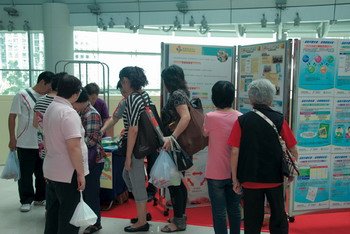
(3) Refined Regulatory Framework for Pesticide Residues in Food
To facilitate effective regulatory control of pesticide residues in food, the CFS held a number of public consultation forums to further solicit views on the "Proposed Regulatory Framework for Pesticide Residues in Food". Apart from commenting on related issues, the participants at the forums also put forward a lot of valuable opinions. The CFS would like to thank them for their enthusiastic participation.
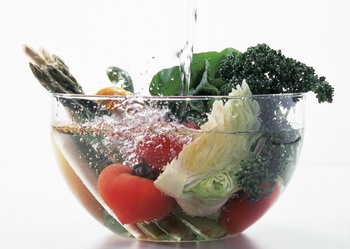
Food Safety Q&A
Purple sweet potatoes will undergo colour changes?
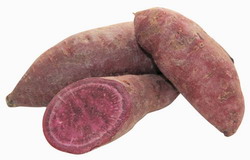
The purple sweet potato is a tasty food for both the old and the young. Have you ever found purple sweet potatoes turning to a different colour during the cooking process? Have you suspected the use of artificial colouring in these potatoes? But actually this is not the case. The purple sweet potato contains a natural colour known as anthocyanin, which will exhibit colour changes over a wide range of pH. Anthocyanins are not only present in purple sweet potatoes, but also in many edible fruits and vegetables such as grapes, berries and red cabbages, and are generally innocuous for human consumption. Colour seepage when processing purple sweet potatoes is thus a natural phenomenon that we need not worry about. In fact, the nutritional value of sweet potatoes is very high. They have a rich content of dietary fibre. When taken in moderation, they can help accelerate the intestinal movement and prevent constipation. Moreover, sweet potatoes have lots of calcium, potassium and vitamins A, C and B etc. Cooked (e.g. baked, roasted, boiled or steamed) sweet potatoes with no seasoning added or dried sweet potatoes can be regarded as a low-fat, low-sodium and high-fibre healthy snack.
Members of the public should pay attention to the following points when buying sweet potatoes:
- Do not buy from unlicensed on-street hawkers. Purchase the potatoes from shops that are reputable.
- Avoid buying sweet potatoes with black spots or abnormally intense colour or those sold at an excessively low price.
- Do not buy the potatoes when in doubt.
Finally, please be reminded that sweet potatoes must be thoroughly cooked before eating. Otherwise indigestion and discomforts such as abdominal distension will result upon consumption. If sweet potatoes are to be cooked unpeeled, their skin must be scrubbed clean beforehand.
Truth against Fallacy
Is Low Fat Food Always Healthier?

While some prepackaged food products bear a low fat claim, they may be rich in other components like sugars and sodium. When purchasing prepackaged food as ingredients for dishes / food products, the trade is advised to take into account the level of other nutrients, including saturated fatty acids and trans fatty acids. After choosing the most suitable ingredients, one should make sure that the ingredients are added in the right amount.
Fat can enrich the taste and texture of food. Among its various bodily functions, fat is the carrier of fat-soluble vitamins (i.e. vitamin A, D, E and K) and is the structural component of cell membrane. However, in the long run, excessive intake of fat, particularly by consuming lots of foods high in saturated or trans fatty acids, will increase the risk of having chronic diseases such as heart disease. Furthermore, as all fatty acids carry the same amount of energy, too much of it will still make one fat. To effectively reduce the fat content in foods so as to offer a healthier food choice for consumers, the trade is advised to use low-fat ingredients and healthy cooking methods (e.g. cook with less oil or even no oil instead of pan-frying or deep-frying). Also, one should avoid using ingredients that are high in saturated fatty acids (e.g. palm oil products, animal skin and fat, processed meat including luncheon meat, sausage, etc.) and those that contain hydrogenated vegetable oil (e.g. hard margarine, shortening, cookies etc.).